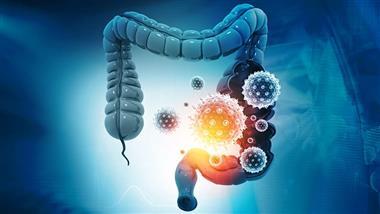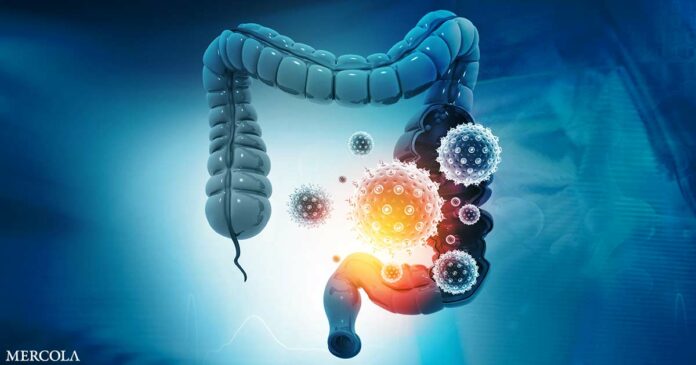
Story at-a-glance
- Gut health is central to overall wellness, with imbalances causing fatigue, weight gain and inflammation across multiple body systems
- Combining specific probiotics with plant compounds creates synergistic effects that reduce inflammation and strengthen gut barrier function
- Short-chain fatty acids, especially butyrate, strengthen gut lining integrity and regulate immune function, while Akkermansia muciniphila bacteria supports the protective mucus layer where butyrate-producing microbes thrive
- Timing matters in gut healing — first remove inflammatory foods like vegetable oils and fix the terrain before gradually introducing fiber and probiotics tailored to your specific condition
- Daily habits like avoiding environmental toxins, getting quality sleep and minimizing vegetable oils high in linoleic acid significantly impact microbiome balance and gut health
If you’ve been battling fatigue, weight gain or inflammatory flare-ups, your gut is likely at the root of it. This isn’t just about discomfort after meals. Your digestive tract is the command center for dozens of important functions, from blood sugar regulation to brain chemistry. When your microbial balance is off, the ripple effects show up across your entire body.
What you feed your gut, both in terms of food and bacteria, has the power to either restore or unravel your health. But not all strategies work in every stage of recovery. Timing, strain selection and your body’s readiness all matter.
Emerging research now pinpoints how specific probiotics and plant-based compounds rebuild gut resilience, repair immune function and reduce inflammation when used correctly. Let’s break down what the latest science reveals and how to apply it step by step to support long-term metabolic healing.
Probiotics and Plant Nutrients Work Better Together to Heal Your Gut
A review published in Food Chemistry Advances analyzed how probiotics and plant compounds impact your gut microbiota and reduce inflammation.1
The researchers reviewed evidence on the synergistic role of these compounds in managing metabolic diseases, particularly cardiovascular disease and Type 2 diabetes. The review emphasized that while probiotics alone are beneficial, combining them with bioactive plant compounds supercharges their effects on gut and immune function.
• People with metabolic disorders and chronic inflammation benefit most — The review focused on how these strategies support people struggling with metabolic imbalances. These include individuals with obesity, Type 2 diabetes, cardiovascular issues or inflammatory bowel conditions.
The researchers highlighted that dysbiosis — an imbalance in gut bacteria — is a common thread in these diseases. The combination of targeted probiotics and plant-derived bioactives helped reduce systemic inflammation, strengthen gut barrier function and rebalance microbial diversity.
• Specific probiotic strains showed unique benefits — Lactobacillus rhamnosus and Lactobacillus plantarum helped build a stronger gut lining by boosting mucin — a slippery protein that forms protective mucus — and tightening the junctions between your gut cells.
This matters because a strong gut lining keeps toxins out of your bloodstream. Bifidobacterium longum and Bifidobacterium breve excelled at breaking down fiber into short-chain fatty acids (SCFAs) like butyrate, a compound that fuels your colon cells and helps manage inflammation.
• Certain plant compounds enhanced probiotic performance — Polyphenols found in tea, berries and cocoa supported the growth of beneficial bacteria while slowing the spread of harmful ones. These plant compounds were also transformed by probiotics into anti-inflammatory substances that helped reduce gut permeability and oxidative stress. Prebiotics such as inulin provided “food” for the probiotics, enhancing their survival and output of SCFAs.
How These Compounds Work Together to Strengthen Gut and Immune Function
When probiotics fermented dietary fibers, they produced the SCFAs butyrate, acetate and propionate — each playing a specific role. Butyrate tightened the gut lining and improved immune tolerance. Acetate supported mucus production and propionate optimized cholesterol and regulated blood sugar. These SCFAs helped create a healthy environment for the microbiome to thrive.
• Beneficial strains like Akkermansia were also covered — Akkermansia muciniphila strengthened the gut’s mucus layer and reduced chronic inflammation linked to obesity and insulin resistance. Akkermansia’s activity helps maintain a balanced and healthy mucus barrier. Akkermansia’s metabolism of mucus sugars also produces beneficial byproducts that further support gut health.
• Bioactives and probiotics help calm your immune system — The study showed that certain plant compounds and probiotics work together to keep inflammation in check. They do this by activating immune cells that release calming signals, which tells your immune system to relax. At the same time, they help lower levels of chemicals that cause inflammation, which is often high in people with metabolic issues.
• The gut-brain axis also influences mental health were also touched on — Butyrate and other SCFAs influenced neurotransmitter production and reduced oxidative stress in brain cells. By calming the gut, these compounds helped improve mood, cognitive clarity and stress resilience. This reinforces the idea that your mental well-being is deeply connected to the health of your microbiome.
• Food delivery systems matter for probiotic survival — The researchers emphasized that not all probiotic foods are equal. The structure of the food, known as the food matrix, must protect probiotics from stomach acid and ensure they reach your colon alive. Fermented dairy, fiber-rich vegetables and synbiotic products, which combine probiotics and prebiotics, offered the best results.
Not All Probiotics Are Created Equal — And Timing Is Everything
According to the National Institutes of Health (NIH) Office of Dietary Supplements, probiotics are live microorganisms that deliver health benefits — but only when the right strains are used at the right dose and at the right time.2
The NIH’s overview specifically focuses on how these organisms interact with your gastrointestinal system, and what makes them truly effective — or not. It’s an important reminder that not every product labeled “probiotic” actually works the way you think it does.
• Probiotics are most effective in specific situations — The report emphasizes that different strains serve different purposes. What helps one person with diarrhea might do nothing for someone with irritable bowel syndrome (IBS).
Efficacy depends on several variables: your age, gut microbiota composition, health condition and the strain’s ability to survive digestion and colonize your gut. In short, taking random supplements without a targeted goal is often ineffective.
• Mechanisms of action include gut barrier repair, immune modulation and pH balancing — The NIH explains that probiotics work in a few important ways:
◦ They produce substances SCFAs that help regulate your immune system and reduce gut inflammation.
◦ Certain strains reinforce your intestinal lining by increasing mucin and tight junction proteins, preventing harmful bacteria from leaking into your bloodstream.
◦ Others compete with pathogens by producing antimicrobial compounds or lowering the pH to create an unfriendly environment for invaders.
• The survival of probiotics through digestion is a major obstacle — Probiotics must survive harsh stomach acid, bile and enzymes to reach your gut intact. Many commercial probiotic strains fail to survive the journey.
Yogurt and fermented dairy tend to support better survival, especially when combined with prebiotics or encapsulation technologies. However, some foods labeled “fermented” often contain no live probiotic cultures by the time you eat them, due to pasteurization or processing.
• There’s no one-size-fits-all approach to probiotic therapy — You need to know what you’re trying to fix. The NIH advises consumers and clinicians to select specific strains that match the condition being treated.
• Regulation and labeling of probiotics are still lacking — Labels are often misleading, with strains misidentified or omitted. Product potency (colony-forming units, or CFUs) is frequently inaccurate. Claims like “supports digestive health” have no standardized scientific backing unless tied to specific strains and outcomes.
How to Rebuild Gut Balance and Reduce Inflammation Naturally
If your digestion feels off, your mood is unpredictable or you’re struggling with stubborn inflammation or weight gain, your gut is sending you a message. And it’s not just about what you’re eating — it’s about who’s living inside you. Your gut is home to trillions of microbes that influence everything from how well you digest food to how effectively your immune system and metabolism function.
When those microbial populations get out of balance, your health starts to unravel at every level. Getting your gut back on track isn’t as simple as adding fiber or taking random probiotics. In fact, doing that too soon makes things worse. Here’s how to approach it the right way:
1. Fix the terrain before feeding it — Fiber is essential for gut health, but only when your gut is ready to handle it. If you have dysbiosis or an inflamed gut lining, fermentable fibers feed the wrong microbes, triggering gas, bloating and toxic byproducts like endotoxins. This is known as the fiber paradox: the very substance that promotes a healthy microbiome in the long term worsens symptoms in the short term if introduced too early.
If you’re dealing with inflammation or bacterial overgrowth, start by removing processed foods, which contain vegetable oils packed with linoleic acid (LA), emulsifiers and additives. Focus on easy-to-digest carbohydrates like fruit and white rice until your symptoms stabilize — then begin layering in small amounts of more fibrous carbs like root veggies.
Once your gut health is healed — meaning your bowel habits, bloating and overall comfort are under control — you can expand your diet further. Add non-starchy vegetables, starchy options (sweet potato or squash), beans, legumes and eventually whole grains with minimal processing.
2. Prioritize bacteria that produce butyrate — Butyrate is one of the most powerful healing compounds your body makes — right inside your colon. It fuels the cells lining your gut, seals up leaky junctions, calms immune overactivation and reduces whole-body inflammation.
The catch? You can’t produce butyrate without help from specific gut microbes. Bacteria like Faecalibacterium prausnitzii, Roseburia, and Eubacterium are among the primary butyrate producers in a healthy microbiome.
They thrive on fermentable fibers found in foods like cooked-and-cooled potatoes, green bananas, lentils, Jerusalem artichokes and oats. Once your gut lining begins to heal, feeding these bacteria becomes a top priority.
But there’s another key player that helps enable their success: Akkermansia muciniphila. While not a butyrate producer itself, Akkermansia plays a supportive role by maintaining and thickening your gut’s mucus layer, creating an ideal environment for butyrate-producing microbes to thrive.
Think of Akkermansia as a gatekeeper that improves the terrain, while Faecalibacterium and others generate the fuel. Together, they create a microbiome that’s stable, anti-inflammatory and metabolically protective.
3. Feed Akkermansia correctly — Akkermansia muciniphila is a gut microbe that helps maintain your mucosal lining. Higher levels are strongly associated with improved blood sugar control, lower inflammation, stronger gut barrier function and even reduced body fat. This bacteria doesn’t just protect your gut — it helps fuel butyrate producers by enhancing the mucus layer they feed on.
Polyphenol-rich foods like pomegranate, red grapes, cranberries and green tea directly promote its growth. So do inulin-containing plants like garlic, leeks, chicory root and asparagus. Start with small amounts and build as tolerated. The goal is to gently coax a resilient ecosystem — not overload a fragile one.
4. Support gut health at the cellular level — Beyond just adding fiber, you need to remove factors that actively damage your gut environment. One major culprit is excessive LA from vegetable oils like sunflower, safflower, soybean and canola oil. These oils disrupt your mitochondrial function, decreasing your cellular energy production and wrecking your gut environment.
Switch to healthier fats like butter, ghee or tallow instead. Also, minimize exposure to endocrine-disrupting chemicals and electromagnetic fields (EMFs), as these further impair cellular energy and negatively impact the oxygen-free gut environment that beneficial bacteria like Akkermansia need to thrive.
Most people have very low levels of Akkermansia in their gut. After you eliminate vegetable oils for at least half a year, considering taking a timed-release Akkermansia supplement. This formula allows more of the bacteria to survive and reach your colon.
5. Rebuild daily habits that reinforce microbial balance — Your microbiome doesn’t just respond to food — it responds to rhythm. Eating at regular times, getting early morning sunlight, sleeping deeply and managing stress all shape your gut flora. Lack of movement, poor sleep, exposure to environmental toxins or antibiotics, or erratic eating disrupts microbial stability just as much as junk food.
Begin with consistency. Eat a wide variety of whole foods — especially colorful vegetables, fermented foods, herbs and spices. Rotate your fibers to avoid overfeeding any one species. Sip green tea and avoid falling into a pattern of eating the same five “healthy” foods every day.
If your gut has been working against you, this step-by-step strategy gives you a roadmap back to resilience. It’s not about finding the perfect food or supplement — it’s about rebuilding your entire ecosystem from the ground up. When your gut regains its strength, everything from your mood to your metabolism starts working in your favor again.
FAQs About Probiotics and Gut Health
Q: How do probiotics and plant nutrients work together to heal your gut?
A: Certain probiotics and plant nutrients team up to make your gut stronger and less inflamed. A 2025 review in Food Chemistry Advances found that probiotics like Lactobacillus rhamnosus, along with plant compounds from tea and berries, helped seal the gut lining, calm the immune system and improve gut bacteria balance.
Q: Why is butyrate so important for gut health?
A: Butyrate is a natural substance made by healthy gut bacteria when they digest certain fibers. It feeds the cells that line your gut, keeps your gut barrier strong, controls inflammation and supports your immune system. You can boost butyrate by eating foods like cooked-and-cooled potatoes, green bananas and lentils.
Q: What does Akkermansia muciniphila do for your gut?
A: Akkermansia muciniphila is a variety of helpful gut bacteria that keeps the protective mucus layer thick and healthy. This makes it easier for other good bacteria to grow. Higher levels of Akkermansia are linked to better blood sugar control, lower inflammation and less body fat.
Q: Why does timing matter when adding fiber and probiotics?
A: If your gut is inflamed or out of balance, adding fiber or probiotics too soon makes symptoms worse. First, it’s important to cut out processed foods, especially vegetable oils, and focus on easy-to-digest foods like fruit and white rice. Once your gut is calmer, slowly add fiber-rich foods and probiotics that match your needs.
Q: What simple habits help keep your gut healthy?
A: Eating a variety of whole foods, getting enough sleep, avoiding vegetable oils, staying active and managing stress all help keep your gut bacteria balanced. Eliminating vegetable oils makes a big difference in repairing gut and overall health.
Test Your Knowledge with Today’s Quiz!
Take today’s quiz to see how much you’ve learned from yesterday’s Mercola.com article.
How can you protect yourself from misleading health information?
Source: Source link
Publish Date: 6/2/2025 12:00:00 AM

